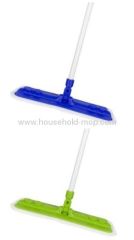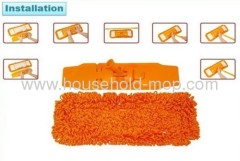




Microfibre Super Mop Head Replacement Refill Cloth Pad Floor Cleaner Sweeper
1.8~1.85 USD
| Min. Order: | 3000 Piece/Pieces |
|---|---|
| Trade Term: | FOB |
| Payment Terms: | L/C, T/T, WU |
| Supply Ability: | 20000pcs/month |
| Place of Origin: | Zhejiang |
Company Profile
| Location: | Ningbo, Zhejiang, China (Mainland) |
|---|---|
| Business Type: | Manufacturer |
Product Detail
| Model No.: | AJ041 |
|---|---|
| Means of Transport: | Ocean, Air |
| Size: | 11-1/2" |
| Length: | 30cm-40cm |
| Style: | Clip On |
| Material: | Metal |
| Usage: | Home |
| Broom Head Material: | PP |
| Width: | 35cm-45cm |
| Brand Name: | Karanfil/OEM |
| Pole Material: | Steel |
| Color: | red,blue,orange ,purple,white,green |
| Dehydration rate: | 90%-100% |
| Hygroscopy: | less then 10's |
| Pole color: | Grey or white or same with the cloth color |
| Corrosion resistance: | Level 10 |
| Production Capacity: | 20000pcs/month |
| Packing: | 1pc/artwork, 12pcs/ctn, Carton size:78 X 29 X 30cm |
| Delivery Date: | 25-30 days after receive the despoit |
Product Description
Porudct name :Microfibre Super Mop Head Replacement Refill Cloth Pad Floor Cleaner Sweeper
Microfibre Flat Mophousehold cleanersand Pole Only with NO Pads by Aquastar in Blue or Green. As Seen On TV brand! This is themop frame only for those who already have pads or want to have extra mop frames. The perfect for home use. It is constructed to use its own Dust Pads, Scrub Pads, or Grout Pads. It is lightweight and has a telescopic handle with swivel head action. Makes going around corners very easy. The Pads attach easily with Velcro strips on the bottom of the mop head. Try using it to dust walls as well as floors. This is the Mop only without pads.
Picture of Microfibre Super Mop Head Replacement Refill Cloth Pad Floor Cleaner Sweeper

Size: Mop Head approximately 15" long x 3 5/8" wide, Handle is 59" long


Microfibre Flat Mophousehold cleanersand Pole Only with NO Pads by Aquastar in Blue or Green. As Seen On TV brand! This is themop frame only for those who already have pads or want to have extra mop frames. The perfect for home use. It is constructed to use its own Dust Pads, Scrub Pads, or Grout Pads. It is lightweight and has a telescopic handle with swivel head action. Makes going around corners very easy. The Pads attach easily with Velcro strips on the bottom of the mop head. Try using it to dust walls as well as floors. This is the Mop only without pads.
Picture of Microfibre Super Mop Head Replacement Refill Cloth Pad Floor Cleaner Sweeper

Size: Mop Head approximately 15" long x 3 5/8" wide, Handle is 59" long
PRODUCT DESPRITION | |
We have more than 10-year experiences on cleaning products. We are a typical China supplier and have worked for home products. We also have factories in China and Thailand in order to meet customers' needs. | |
Name | Value |
Brand | Karanfil |
Production Capacity | 500000 Piece/Pieces per Month |
Material | Chenille and microfiber |
Terms | FOB Ningbo |
Place of Origin | China |
Feature | ECO-friendly |
Payment terms | 30% deposit before we make the production, 70% balance paid after we finished the order. |
Order delivery | 25-30days after receiving 30% deposit |
Packing | 1pcs/polybag,50pcs/inner box,1000 or 500 pcs/out carton |
Shipment means | by sea, by air, by express etc. |

How to Install a Laminate Tile Floor
Begin from the left side of the room and work towards the right. Connect the laminate tile floor planks together using a rubber mallet until each piece snaps together tightly. Check all of the edges of each plank to ensure that each groove and tongue is in perfect condition. If any imperfections or broken edges are allowed to be placed down, then you will have huge imperfections and it can void the warranty of your tile laminate floor.

Mark around all pipes and protrusions with a carpenter pencils. Lay the pencils width against the object you are trying to scribe. Place the tile lament flooring under the pencil and slowly scribe the plank. You can clamp the plank to a sawhorse and cut it using a jigsaw or coping saw. A compass will work well for large protrusions or awkward angles. You may also need to create a template for multiple intricate cuts. Cut a piece of cardboard to the exact size of the plank you need. Use a utility knife to trim the piece until it fits perfectly and then transfer the pattern on the cardboard to the tile laminate floor.
Once you have created a long strip along the first wall, shim the plank from the end of the wall ¼-inch. Shim ¼ inch off the other wall as needed. Take a plank and turn it upside down. Place it against the end of your first row. Make a mark even with the groove and cut it, using a power miter saw. Now attach the last piece into place with a rubber mallet and tapping block/shoe. Shim it with a ¼ piece of wood.
Now you can begin to lay the next row. Go back to where you started and center a piece on the next row, so as to stagger the joints. Make sure the false grout lines up well. You will need to cut this piece with the miter box. You may need to undercut the length. This will ensure you have a correct fit. Re-cut as needed until it fits perfectly. Continue along the line adding planks as needed, staggering all joints and aligning the false grout lines perfectly. Tap each plank into place with the rubber mallet and tapping block/shoe as you continue down the line. As you add each piece into place, continually check that the shims are in place and a ¼-inch gap is maintained along each wall.

Mark around all pipes and protrusions with a carpenter pencils. Lay the pencils width against the object you are trying to scribe. Place the tile lament flooring under the pencil and slowly scribe the plank. You can clamp the plank to a sawhorse and cut it using a jigsaw or coping saw. A compass will work well for large protrusions or awkward angles. You may also need to create a template for multiple intricate cuts. Cut a piece of cardboard to the exact size of the plank you need. Use a utility knife to trim the piece until it fits perfectly and then transfer the pattern on the cardboard to the tile laminate floor.
Once the floor is all done and snapped into place, make sure it is still shimmed ¼ inch around all walls and cabinets. Attach the base on top of the flooring to the walls as needed. If the base is already down, then shoe molding is required to close the gap between the walls and the flooring. Finally install all of the transition strips. Cut each strip to length to fit between doors and openings. You can glue them into place using liquid nail or other similar wood glue. Wipe away any excess glue with a damp sponge. Now your floor is complete and ready to be enjoyed!


